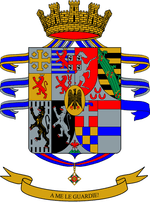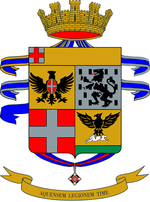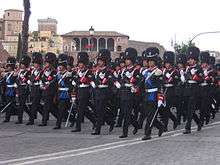Granatieri di Sardegna Mechanized Brigade
| Brigata Meccanizzata "Granatieri di Sardegna" | |
|---|---|
|
Coat of Arms Granatieri di Sardegna Brigade | |
| Active |
25 October 1831 - 20 April 1850 Guards Brigade 20 April 1850 - November 1852 Granatieri Brigade November 1852 - 25 October 1871 Granatieri di Sardegna Brigade 2 January 1881 - 8 February 1934 Granatieri di Sardegna Brigade 8 February 1934 - 10 September 1943 Granatieri di Sardegna Infantry Division 15 May 1944 - 31 August 1944 Granatieri Division 1 April 1948 - 1 November 1976 Granatieri di Sardegna Infantry Division 1 November 1976 - today Granatieri di Sardegna Mechanized Brigade |
| Country | Italy |
| Allegiance | Italian Army |
| Branch | Army |
| Type | Brigade |
| Role | Infantry |
| Part of | COMFOD 2° |
| Garrison/HQ | Rome |
| Colors | red |
| Engagements |
World War I World War II Bosnia SFOR Kosovo KFOR Afghanistan ISAF Iraq Multinational force in Iraq |
| Commanders | |
| Current commander | Brigadier Giovanni Armentani |
The Granatieri di Sardegna Mechanized Brigade (Grenadiers of Sardinia Mechanized Brigade) is a mechanized infantry brigade of the Italian Army, based mainly in Rome and central Italy. The brigade fields one of the oldest regiments of the Army and is one of the guard regiments of the Italian president. The name of the unit dates back to the Kingdom of Sardinia and not the eponymous Mediterranean island of Sardinia.
History
1831 & before
After the ascension to the throne of Charles Albert of Sardinia on 27 April 1831 a major reform of the military of the Kingdom of Piedmont was undertaken. Thus on 25 October 1831 the Guards Grenadiers Brigade (Brigata Granatieri "Guardie") was raised as one of 10 infantry brigades of the kingdom. The brigade consisted of the 1st Grenadiers Regiment (1° Reggimento Granatieri), with four battalions of four companies each and a depot battalion of four companies, and the 2nd Hunters Regiment (2° Reggimento Cacciatori), with three battalions of four companies each and a depot battalion of three companies.
The 1st Grenadiers Regiment was founded as Regiment of the Guards (Reggimento delle Guardie) on 18 April 1659 by the Duke of Savoy Charles Emmanuel II as his personal bodyguard regiment during military campaigns. The regiment participated in the War of the Spanish Succession where it excelled during the Siege of Turin. After the Duchy had been elevated to kingdom in 1720 the regiment fought in the War of the Polish Succession and War of the Austrian Succession, during which the regiment performed exceptionally brave during the Battle of Assietta.
During the War of the First Coalition the regiment fought in the Italian campaigns against the French Army of Italy under Napoleon Bonaparte. After France annexed the Kingdom of Sardinia in 1799 the royal family went into exile on Sardinia and the Regiment of the Guards was disbanded.
The 2nd Hunters Regiment was founded on 13 July 1774 as Regiment of Sardinia (Reggimento di Sardegna) on the eponymous island and served as the guard regiment of the royal family during their exile there. After the defeat of Napoleon at the Battle of Leipzig in 1813 the royal family returned to Turin and the re-building of the Sardinian Army commenced in 1814. In 1814 the Regiment of the Guards was raised again as the "Guards" Regiment (Reggimento "Guardie"), while the Regiment of Sardinia moved to Turin, where it was renamed as Guard Hunters Regiment (Reggimento Cacciatori Guardie).
When the two regiments were combined in a single brigade in 1831 they became the first units in the order of precedence of the kingdom.
1831 to 1914
The brigade participated in the First Italian War of Independence fighting in the battles of Santa Lucia, Goito, Pastrengo and Custoza. During the Battle of Goito the Sardinian King Charles Albert rallied the Guards Grenadiers Brigade to his position with the words "a me le guardie!" ("Guards to me!"), which became the motto of the brigades regiments. After the war on 20 April 1850 the brigade was renamed as Grenadier Brigade (Brigata Granatieri) and its regiments were renamed as 1st and 2nd Grenadier Regiment.
In 1855 the brigade provided two battalions for the Sardinian Expeditionary Corps in the Crimean War. During the Second Italian War of Independence the brigade was involved in a skirmish near Lonato del Garda in June 1859. After the war the brigade participated in the occupation of Umbria and the Marche regions of the Papal States which was completed when the Papal Army surrendered the fortress of Ancona on 29 September 1860. Afterwards the brigade as part of the 1st Division of the Line under the V Army Corps entered the Kingdom of the Two Sicilies to aid Giuseppe Garibaldi in his Expedition of the Thousand. The brigade fought at San Giuliano on 26 October 1860 and at Garigliano on 29 October 1860. Finally the brigade participated in the siege of Gaeta.
After Italy had been unified the brigade moved to Florence, the capital of the newly united Italy, where it took on guard duties at the royal palace. During the Third Italian War of Independence in 1866 the brigade fought at the Battle of Custoza. Between 1871 and 1881 the brigade level had been abolished in the Italian Army, but in 1881 the brigade was re-activated with its traditional regiments.
World War I

At the outbreak of World War I the brigade moved to the Italian-Austrian border and after Italys declaration of war on 23 May 1915 the brigade participated in the conquest of Monfalcone on the Adriatic coast. Afterwards the brigade participated in the first four Battles of the Isonzo aimed at conquering the city of Gorizia. The brigade tried to capture the Sabotin hill near Gorizia and later fought at Oslavia. After the brigade had again fought at Oslavia in the Fifth Battle of the Isonzo it was transferred to the Asiago plateau to reinforce the Italian forces there, which were breaking under the massive Austrian-Hungarian Asiago offensive.
There the brigade defended Mount Cenigo- the last position between the Austrians and the Italian plains. A loss of the mountain would have let to the encirclement of the Italian Armies along the Isonzo front. On Mount Cenigo the Granatieri di Sardegna stubbornly held the position even after ammunition had been expended and the enemy had broken into the brigades line. Ultimately the defence of Mount Cenigo ensured that the Austrians had to abandon the offensive.
After the Austrian offensive had been defeated the brigade returned to the Isonzo front and participated in the sixth, seventh, and eighth Battle of the Isonzo. During 1917 the brigade continued to fight along the Isonzo river. After the Italian retreat after the defeat in the Battle of Caporetto the brigade had to be rebuilt. In 1918 the brigade fought in the last two big battles on the Italian front - the Battle of the Piave River and the Battle of Vittorio Veneto.
After the war the brigade was garrisoned in Rome, where a third Grenadier Regiment was raised. The brigade and its three regiments came under the 21st Infantry Division on 1 December 1926. On that date the brigade was renamed as XXI Infnatry Brigade, while the three grenadier regiments became the 1st, 2nd and 3rd Granatieri di Sardegna Regiment.
World War II
On 8 February 1934 the 21st Infantry Division received the name Granatieri di Sardegna. In 1939 the 21st Infantry Division Granatieri di Sardegna lost the 3rd Granatieri di Sardegna Regiment. The division entered World War II with the two Granatieri di Sardegna regiments, the 13th Artillery Regiment and some minor units.
In June 1940, it was mobilized and took part in the Italian invasion of France as a part of the Italian VII Army, but due to the quick German victory in the Battle of France the division was not involved in any operations before the French surrender.
In spring 1943 the division was moved to Rome to aid in the defence of the city in case of an Allied attack. During this time the division was reorganized along the lines of the Mod.43 reform of the Italian Army and was augmented with the XXI Mortar Battalion. In total the division fielded 14,500 troops. After the armistice between Italy and Allies of 8 September 1943 the division found itself fighting Italy's former allies the Germans and along with the 12th Infantry Division Sassari and 135th Armored Division Ariete II the Granatieri defended Rome. The Granatieri fought along the Via Ostiensis for two days before falling back to the Porta San Paolo where the division fought a last stand. There the division was joined by remnants of the Sassari division, the 8th Cavalry Regiment Lancieri di Montebello and hundreds of civilian volunteers. The future Italian president Sandro Pertini brought a detachment of Socialist resistance fighters to Porta San Paolo were they received the weapons of fallen grenadiers. Civilians at Porta San Paolo included communist leader Luigi Longo, lawyer Giuliano Vassalli, writer Emilio Lussu, unionist leaders Vincenzo Baldazzi, Mario Zagari, retired Air Force generals Sabato Martelli Castaldi and Roberto Lordi, and 18-year-old future partisan leader Marisa Musu. Around 12:30 the Catholic Communist movement arrived with reinforcements including famed actor Carlo Ninchi. However, by 17:00 the Germans broke the line of the Italian defenders, who had suffered 570 dead. Soon after the Italian military units surrendered to the Germans as the flight of the Italian King Victor Emmanuel III from Rome had made further resistance senseless. However the Italian soldiers handed thousands of weapons over to the civilian population, which was quick to form an organized resistance movement in the city of Rome.
For their role in the defence of the Rome the 1st Granatieri di Sardegna Regiment and the 8th Cavalry Regiment Lancieri di Montebello were awarded with the Gold Medal of Military Valour.
After the surrender of the Granatieri di Sardegna division three Granatieri battalions based in Corsica refused to surrender to the Germans and along with the 20th Infantry Division Friuli, 44th Infantry Division Cremona, 225th Coastal Division, 226th Coastal Division and French Partisans began to fight retreating German troops. The German Sturmbrigade Reichsführer SS and 90th Panzergrenadier Division and the Italian 12 Parachute Battalion of the 184 Parachute Regiment,[1] which had come from Sardinia tried to retreat through Corsica towards the harbour of Bastia in the islands north. On 13 September elements of the Free French 4th Moroccan Mountain Division landed in Ajaccio to support the Italian efforts to stop the 30,000 retreating Germans. However the Germans managed to escape.
By augmenting the existing three battalions the Italian Co-Belligerent Army managed to raise the Granatieri di Sardegna division anew in Sardinia on 15 May 1944. The division consisted of the 1st and 2nd Grenadier Regiments, the 32nd and 132nd Armoured Infantry Regiments, 548th and 553rd Artillery Regiments and an Engineer Company. However it was decided that the infantry units of the division should join the Friuli Combat Group in Italy. On August 31 the Granatieri division was disbanded with the remaining units used to augment the Cremona Combat Group.
Cold War
After World War II the Italian Army began to rebuild its units with American help. On 1 July 1946 the 1st Granatieri di Sardegna Regiment was raised again in Rome. On 1 April 1948 in Roma Granatieri di Sardegna Infantry Division is raised in Rome. At first the divisions consists of the 1st Grenadier Regiment, 17th Infantry Regiment and the 13 Field Artillery Regiment. The division increased in size over the following years and by 1964 consisted of the:
-
 1st Granatieri di Sardegna Regiment with three motorized infantry battalions
1st Granatieri di Sardegna Regiment with three motorized infantry battalions -
 17th Infantry Regiment Acqui with three motorized infantry battalions
17th Infantry Regiment Acqui with three motorized infantry battalions -
 3rd Armoured Infantry Regiment with the LXVII Bersaglieri Battalion and the XXXI Tank Battalion
3rd Armoured Infantry Regiment with the LXVII Bersaglieri Battalion and the XXXI Tank Battalion -
 13th Artillery Regiment with three artillery and one air-defence group
13th Artillery Regiment with three artillery and one air-defence group -
 XIV Reconnaissance Squadron Cavalleggeri di Alessandria
XIV Reconnaissance Squadron Cavalleggeri di Alessandria - VIII Engineer Battalion
- VIII Signal Battalion
On 1 October 1975 the Italian Army abolished the regimental level and battalions came under direct command of brigades. Therefore, the army decided to split the Granatieri di Sardegna Motorized Division into two brigades. On 30 September 1975 the 17th Infantry Regiment Acqui was disbanded and on 1 October 1975 the Motorized Brigade Acqui raised in its stead. The Granatieri di Sardegna division remained active for one more year to change from a motorized to a mechanized unit.
On 1 November 1976 the division was contracted to brigade and renamed as Granatieri di Sardegna Mechanized Brigade. The brigade commanded the following units after the reform was complete:
- Granatieri di Sardegna Command and Signal Battalion in Rome
-
 1st Mechanized Granatieri Battalion Assietta in Rome
1st Mechanized Granatieri Battalion Assietta in Rome -
 2nd Mechanized Granatieri Battalion Cengio in Rome
2nd Mechanized Granatieri Battalion Cengio in Rome -
 3rd Mechanized Granatieri (Training) Battalion Guardie in Orvieto
3rd Mechanized Granatieri (Training) Battalion Guardie in Orvieto -
 1st Mechanized Bersaglieri Battalion La Marmora in Civitavecchia
1st Mechanized Bersaglieri Battalion La Marmora in Civitavecchia -
 6th Tank Battalion M.O. Scapuzzi in Civitavecchia
6th Tank Battalion M.O. Scapuzzi in Civitavecchia -
 13th Self-propelled Field Artillery Group Magliana in Civitavecchia
13th Self-propelled Field Artillery Group Magliana in Civitavecchia -
 Granatieri di Sardegna Logistic Battalion in Civitavecchia
Granatieri di Sardegna Logistic Battalion in Civitavecchia - Granatieri di Sardegna 32nd Anti-tank Company in Civitavecchia
- Granatieri di Sardegna Engineer Company in Civitavecchia
The brigade was tasked with the defence of Rome as well as public duties.
With the end of the Cold War the Italian Army began to draw down its forces and it ordered the battalions to be called again regiments for traditional reasons. On 30 November 1992 the 32nd Anti-tank Company was disbanded, and on 4 October 1993 the Engineer Company entered the Command and Signal Battalion, which was renamed as Command and Tactical Support Battalion. The same year the 6th Tank Battalion was renamed as 4th Tank Regiment and on 9 October the regiment was transferred to Bellinzago Novarese were it joined the Legnano Mechanized Brigade. On 21 December 1995 the 13th Self-propelled Field Artillery Group was replaced by the 7th Self-propelled Field Artillery Group Cremona, which had come from the Cremona Motorized Brigade. However already on 15 May 1996 the 33rd Self-propelled Field Artillery Group Acqui joined the brigade when the Army decided to disband the Acqui Motorized Brigade and the 7th Self-propelled Field Artillery Group Cremona was transferred to Armys Artillery Command to become a NBC-defence unit. At the same time the 8th Cavalry Regiment Lancieri di Montebello entered the brigade and the 3rd Granatieri Regiment left the brigade. After the last round of reforms in 1997 the brigade consisted of the following units:
- Granatieri di Sardegna Command and Tactical Support Battalion in Rome
-
 1st Granatieri di Sardegna Regiment in Rome
1st Granatieri di Sardegna Regiment in Rome -
 2nd Granatieri di Sardegna Regiment in Spoleto
2nd Granatieri di Sardegna Regiment in Spoleto -
 1st Bersaglieri Regiment in Rome
1st Bersaglieri Regiment in Rome -
 8th Cavalry Regiment Lancieri di Montebello in Rome
8th Cavalry Regiment Lancieri di Montebello in Rome -
 33rd Self-propelled Field Artillery Group Acqui in L'Aquila
33rd Self-propelled Field Artillery Group Acqui in L'Aquila -
 Granatieri di Sardegna Logistic Battalion in Civitavecchia
Granatieri di Sardegna Logistic Battalion in Civitavecchia

Today
In the following years the brigade was further reduced: on 1 January 2005 the 1st Bersaglieri Regiment was disbanded and the named given to the 18th Bersaglieri Regiment of the Garibaldi Bersaglieri Brigade. Since 2000 the brigade has deployed its units three times as part of KFOR in Kosovo and once as part of UNIFIL in Lebanon. With the abolition of mandatory military service in Italy in 2004 the required height to join the Grenadiers was lowered from 190 cm to 180 cm. At the same time the 2nd Granatieri di Sardegna Regiment in Spoleto was reduced to two mechanized companies that came under the 1st Granatieri di Sardegna Regiment.
In 2013 it was announced that the brigade would be disbanded by 2016. The 33rd Artillery Regiment Acqui was used in 2013 to create the 185th Airborne Artillery Regiment of the Folgore Parachute Brigade, while the 8th Cavalry Regiment Lancieri di Montebello will join the Pinerolo Mechanized Brigade. The 1st Granatieri di Sardegna Regiment will become a guard regiment under the Infantry School in Rome, tasked with public duties in the Italian capital.
Equipment
The Lancieri di Montebello cavalry regiment is equipped with Centauro wheeled tank destroyers and Puma 4x4 armored personnel carriers. The 1st Granatieri di Sardegna regiment has been equipped in 2010 with Dardo tracked infantry fighting vehicles.
References
- ↑ "Esercito Italiano: Divisione "NEMBO" (184^)". Archived from the original on 2009-05-14. Retrieved 2009-04-19.
